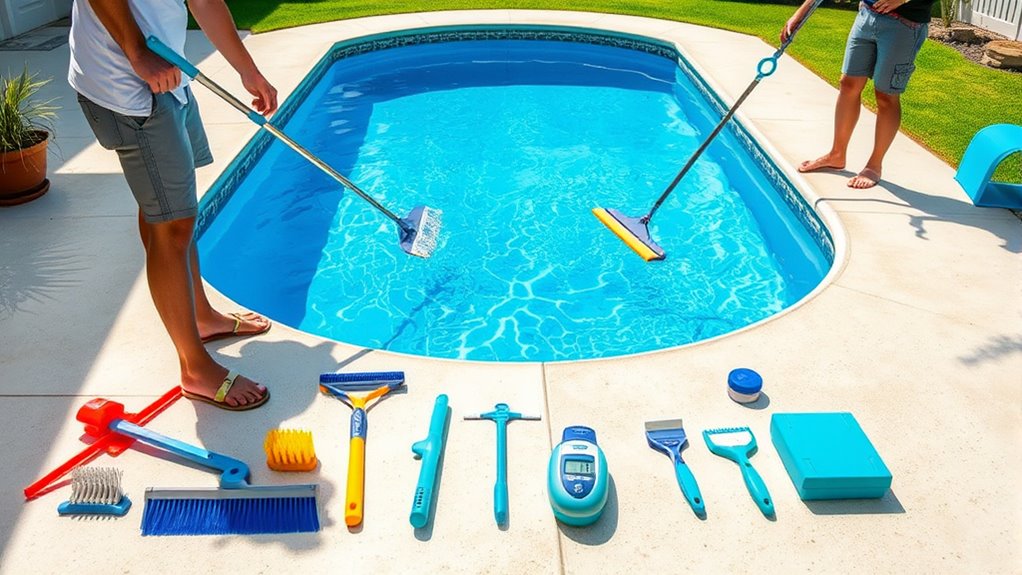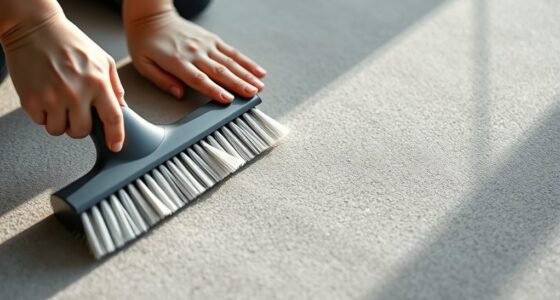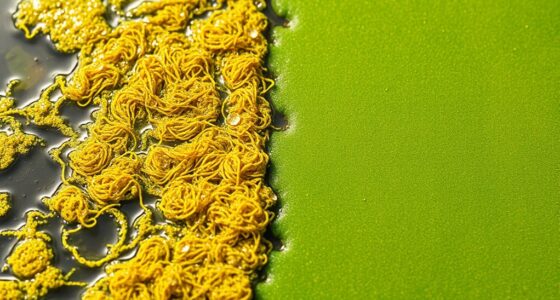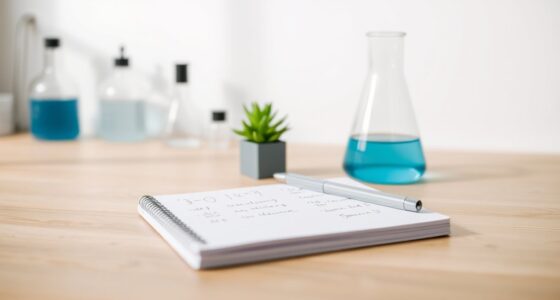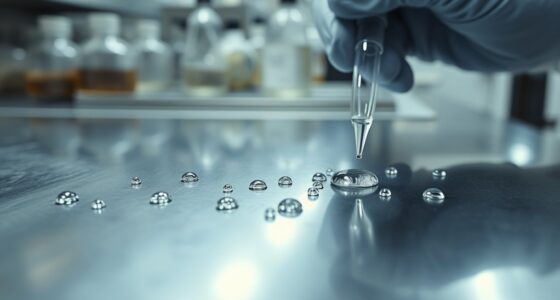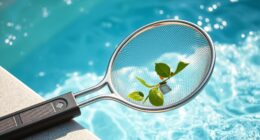To keep your pool sparkling in under 30 minutes, start by skimming the surface for leaves and debris. Test your water’s pH, chlorine, and alkalinity, then adjust chemicals accordingly. Brush the walls and floor to remove algae. Clean the skimmer and pump baskets, checking water levels and adjusting as needed. Inspect and clean the filter, and guarantee your equipment operates smoothly. Wipe down accessories and surrounding areas to maintain a tidy, inviting pool—discover more tips to streamline your weekly routine.
Key Takeaways
- Skim the pool surface and remove debris from skimmer baskets daily to prevent clogging and maintain water flow.
- Test water chemistry (pH, chlorine, alkalinity) and adjust chemicals as needed for clarity and safety.
- Run the pump and filter system for 8-12 hours to ensure proper circulation and debris removal.
- Rinse and inspect filter cartridges or grids, soaking or replacing if necessary, for optimal filter performance.
- Wipe down floats, noodles, and surrounding surfaces, and clear debris from deck areas to keep the pool area tidy and inviting.
Skim the Pool Surface for Debris
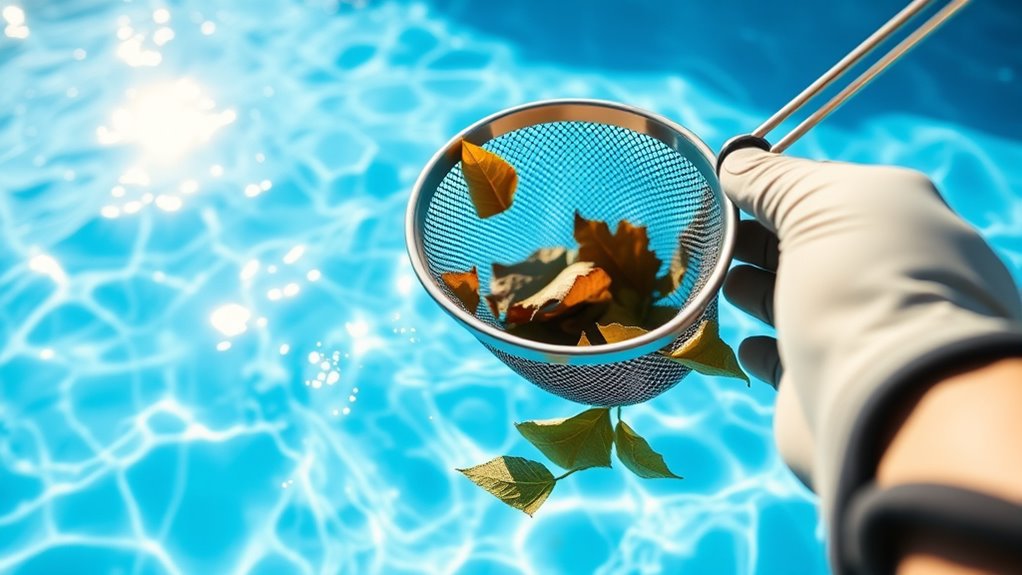
Have you ever noticed leaves, bugs, or other debris floating on your pool’s surface? Skimming the pool is a quick, essential step in your weekly routine. Grab a pool net or skimmer and gently drag it across the surface to lift debris. Doing this regularly prevents debris from sinking and causing stains or clogging your filter. It also improves water clarity and makes your pool look inviting. Spend a few minutes moving the net smoothly across the surface, focusing on areas where debris tends to gather. Don’t forget to empty the skimmer basket afterward, so it’s ready for the next time. Skimming is a simple task that keeps your pool clean and extends the life of your equipment. Regular surface debris removal enhances overall water quality and supports your pool’s filtration system.
Test Water Chemistry and Adjust Chemicals
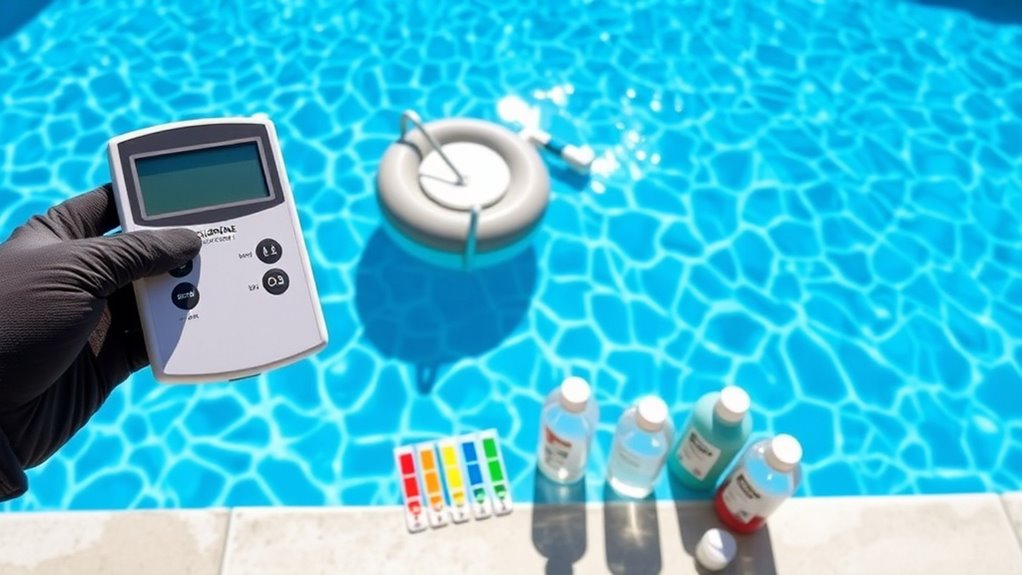
Testing your pool water regularly is essential to maintain a safe and balanced environment. You’ll need to check pH levels, chlorine or sanitizer levels, and alkalinity to ensure everything stays in balance. Use a reliable test kit or strips to quickly get accurate readings. Once you have your results, modify chemicals as needed to keep your water clear and healthy. Imagine:
- Adding pH increasers or decreasers to keep the water balanced
- Pouring in chlorine or sanitizer to maintain proper disinfection
- Adjusting alkalinity to prevent corrosion or scaling
- Understanding water chemistry helps you make informed adjustments for optimal pool health
Brush the Pool Walls and Floor
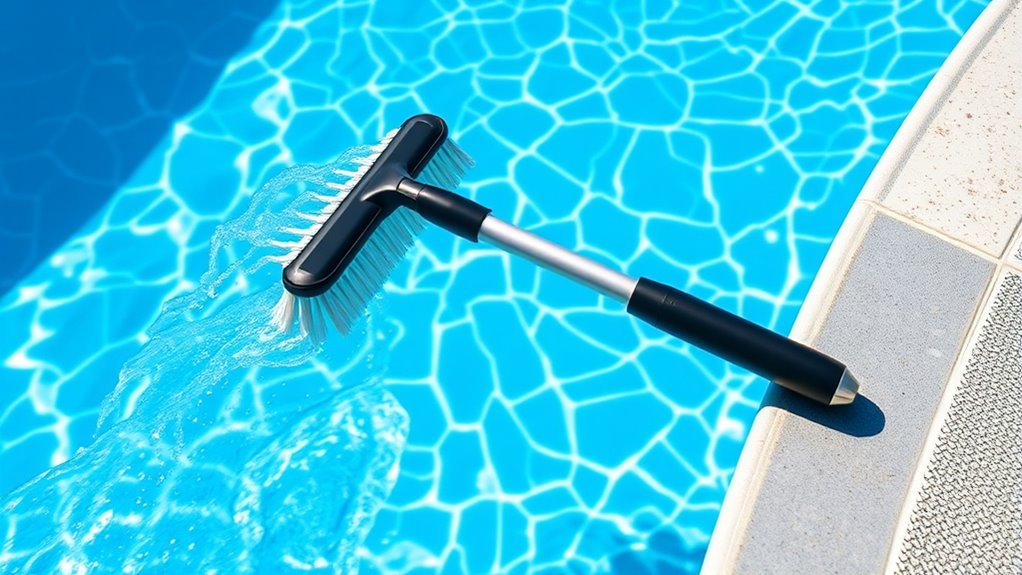
Brushing the pool walls and floor is a crucial step to prevent algae buildup and remove dirt that can dull your water’s clarity. Use a pool brush with a sturdy, non-abrasive bristle suitable for your pool surface—vinyl, plaster, or fiberglass. Start at the waterline and work downward, scrubbing in gentle, circular motions to loosen algae and debris. Pay special attention to corners and steps where buildup tends to accumulate. Regular brushing keeps algae from taking hold and prevents stubborn stains from forming. Make sure to rinse your brush frequently to avoid redistributing dirt. This simple task helps maintain clear, sparkling water and reduces the workload for your filter and chemical treatments. Regular maintenance, including filter cleaning, enhances water quality and system efficiency. Aim to brush your walls and floor once a week for ideal results.
Clean the Skimmer and Pump Baskets
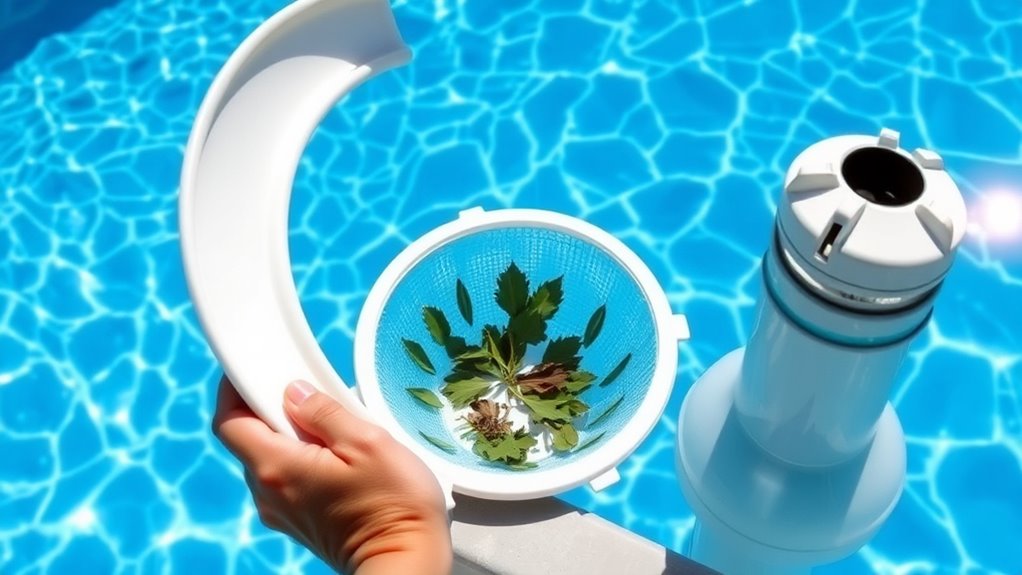
You should remove debris from the skimmer and pump baskets regularly to keep your pool running smoothly. Check the baskets for damage and replace them if needed to prevent issues. If you notice any blockages, clear them right away to maintain proper water flow. Using odor control features in your pool accessories can also help keep the water fresh and clean.
Remove Debris Regularly
Why is it important to remove debris regularly from your pool? Debris can clog your skimmer and pump baskets, reducing water flow and stressing your equipment. When leaves, bugs, or dirt accumulate, they block filtration, making your pool harder to keep clean. Regular removal guarantees your pool stays crystal clear and runs efficiently. Additionally, implementing vertical storage solutions for pool accessories can help keep your area organized and prevent clutter buildup. By clearing out debris, you prevent:
- Leaves and twigs from sinking and decaying in the baskets
- Bugs and dirt from clogging the skimmer and pump pathways
- Algae and bacteria growth caused by trapped organic matter
Keeping baskets clean promotes proper water circulation, reduces strain on your equipment, and simplifies overall maintenance. A quick weekly check keeps your pool functioning smoothly and looking inviting for swim time.
Inspect Basket Condition
Regularly inspecting and cleaning your skimmer and pump baskets guarantees they’re free of debris that could restrict water flow. Remove the baskets from their housing and check for leaves, insects, and other debris. Rinse them thoroughly with a garden hose to clear away dirt and debris. Look for cracks or damage that could compromise their effectiveness. If you spot any cracks or broken parts, replace the baskets promptly to prevent debris from entering your pump or filter system. Verify the baskets are dry before reinserting them to avoid mold buildup. Keeping these baskets clean and in good condition helps your pool’s filtration system operate smoothly, reducing strain on your pump and improving water clarity. Butter’s artistic influence continues to inspire creative expressions, emphasizing the importance of maintaining optimal conditions for artistic endeavors. Make this a weekly routine to keep your pool running efficiently.
Clear Blockages Quickly
When blockages occur, addressing them promptly keeps your pool’s circulation running smoothly. Regularly check and clear your skimmer and pump baskets to prevent debris buildup. Start by turning off the pump, then carefully remove the baskets. Remove leaves, twigs, and other debris, ensuring nothing clogs the flow. Clean out any stubborn dirt or sludge to maintain ideal water flow. As you work, picture leaves and twigs clogging the basket, slowing circulation, dirt and debris compacted at the bottom of the basket, and small particles hiding in corners, blocking water flow. Proper maintenance of your filter components ensures your pool stays clean and well-functioning.
Check and Maintain Water Level
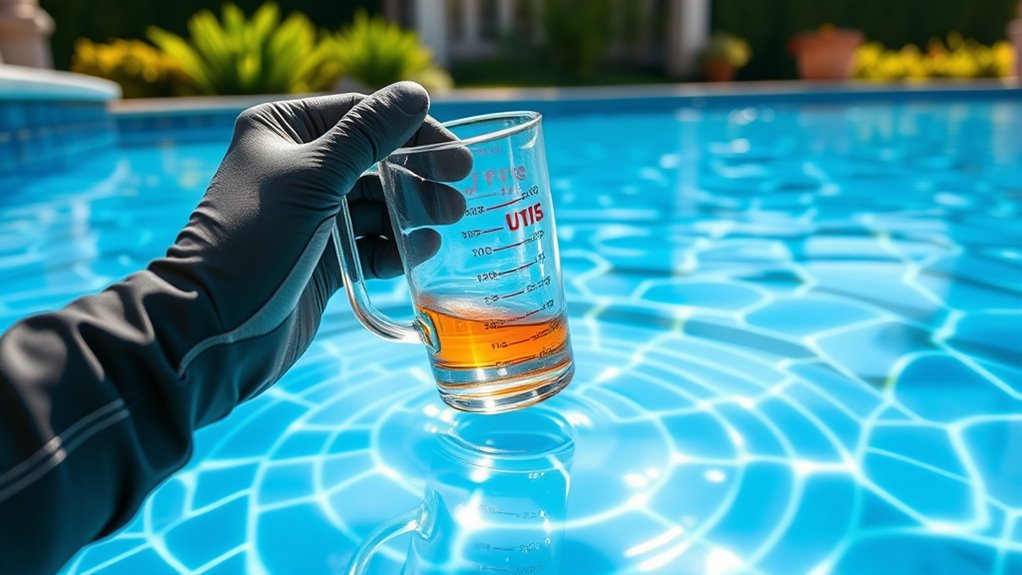
Regularly check your pool’s water level to make sure it’s at the proper height. If it’s low, refill it to maintain the right balance and avoid equipment issues. Keeping the water balanced and topped off helps your pool stay clean and safe to swim in.
Monitor Water Balance
Have you checked your pool’s water level lately? Maintaining proper water balance is essential for clear, healthy water. To do this, test your water’s pH, alkalinity, and sanitizer levels regularly. When you test, you’ll see:
- pH levels that are too high or low, affecting clarity and comfort
- Alkalinity that’s out of range, causing swings in pH
- Sanitizer levels that are too low, risking algae and bacteria growth
Adjust these levels as needed, adding pH increaser or decreaser, alkalinity adjusters, or sanitizer. Keeping your water balanced prevents corrosion, scaling, and cloudy water. Spend a few minutes each week monitoring these parameters to ensure your pool stays inviting, safe, and easy to maintain. Proper balance is the foundation for a pristine swimming environment, and using a reliable air purifier maintenance schedule can help keep the surrounding air quality in check.
Refill as Needed
Ensuring your pool has the correct water level is essential for proper circulation and filtration. If the water drops below the skimmer opening, your pump may run dry or become damaged. Check weekly and add water as needed to keep it at the recommended level. Use a garden hose or a submersible pump for quick refills. Maintaining the proper water level helps prevent pump damage and ensures optimal pool performance.
Run the Pool Pump and Filter System
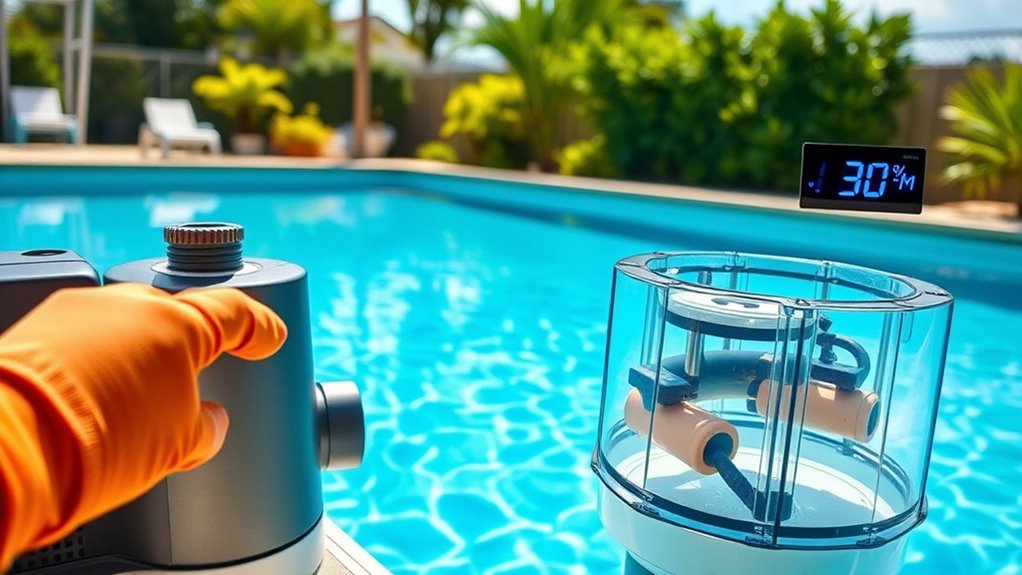
Running your pool pump and filter system is essential for maintaining clear, healthy water. It circulates the water, removes debris, and keeps chemicals evenly distributed. To do this efficiently, verify your pump runs daily for about 8-12 hours. As it operates, imagine:
- A steady stream of water flowing through the system, pulling in leaves and dirt
- The filter trapping particles, creating crystal-clear water
- The pump humming steadily, maintaining consistent circulation
This process prevents algae growth and reduces chemical imbalance. Check that the pump is running smoothly without unusual noises or leaks. Adjust the timer if needed, especially during heavy use or after storms. Regular operation is your first line of defense for a sparkling, healthy pool. High-quality oils can help keep your system running smoothly by preventing buildup and ensuring optimal performance.
Inspect and Clean the Pool Filter
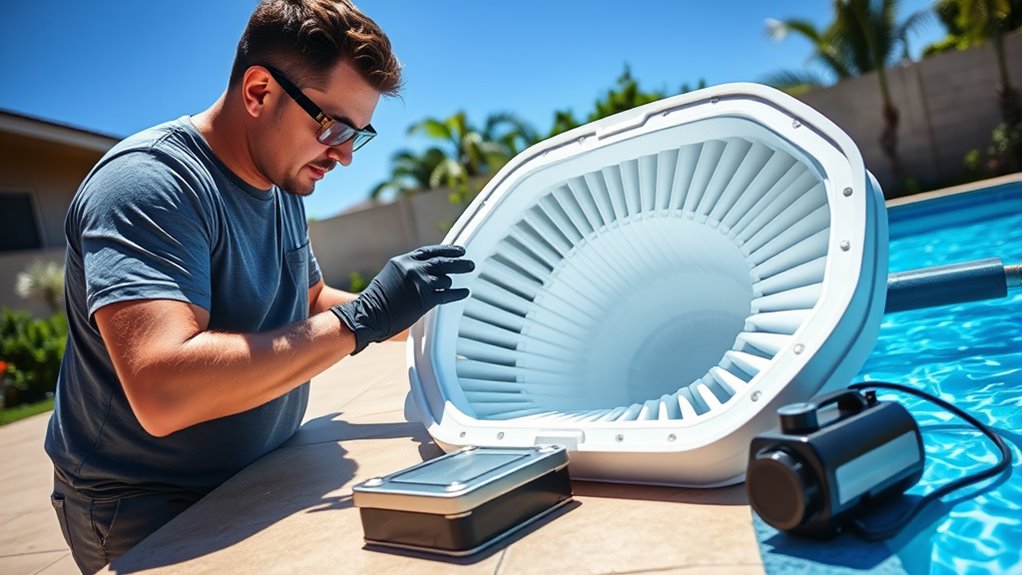
Regularly inspecting and cleaning your pool filter is essential for maintaining ideal water clarity and circulation. Start by turning off your pump and locating the filter. Remove the filter cover and carefully take out the filter cartridge or DE filter grid. Examine it for dirt, debris, or any signs of damage. If it’s dirty, rinse it thoroughly with a garden hose, making sure to wash away all debris trapped in the pleats or grids. For cartridge filters, you can soak them in a filter cleaning solution if needed. Once cleaned and dried, reinstall the filter, secure the cover, and turn the pump back on. Regular cleaning prevents clogging, supports efficient filtration, and keeps your pool water sparkling clean. Aim to inspect and clean your filter weekly for best results.
Check and Adjust Ph and Chlorine Levels
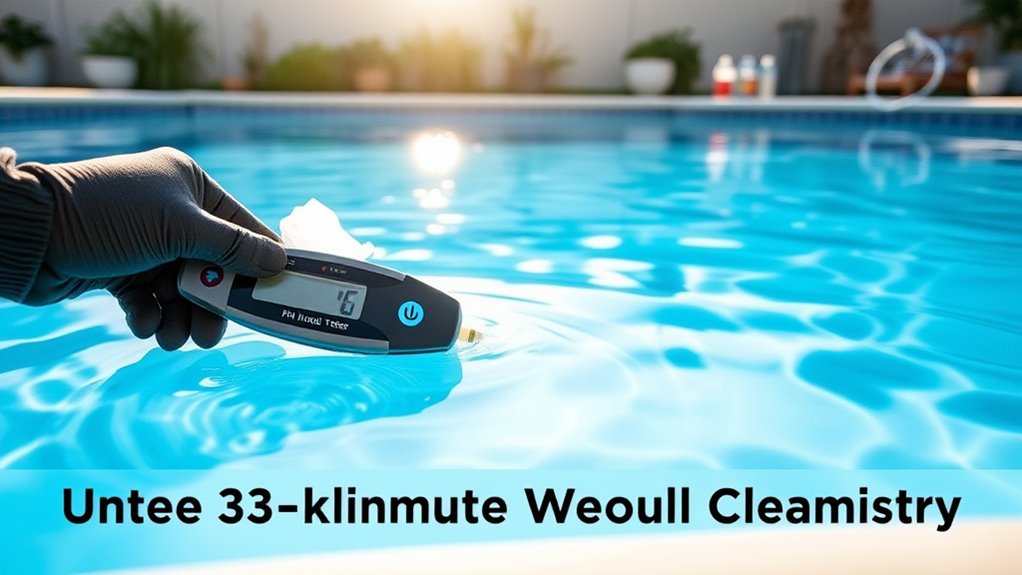
You need to regularly test your pool’s pH and chlorine levels to keep the water safe and balanced. Accurate readings help you determine if adjustments are necessary. Once you know the levels, you can fine-tune the chemicals to maintain ideal water quality.
Test Ph Accuracy
To guarantee your pool water remains safe and comfortable, it’s essential to check and adjust the pH and chlorine levels regularly. Testing pH accuracy ensures your chemical balance is correct, preventing irritating water or scale buildup. Use a reliable test kit or strips to measure the pH level, aiming for 7.2 to 7.6. When testing, picture yourself:
- Carefully collecting a water sample from the pool’s mid-depth
- Dipping the test strip or adding drops to a vial
- Comparing the color to the chart for an accurate reading
If the pH is off, adjust it with pH increaser or decreaser. Accurate testing and adjustments keep your pool water balanced, clear, and comfortable for swimmers. Regular checks save you time and effort in the long run.
Test Chlorine Levels
Checking and adjusting your pool’s chlorine levels is the next step to maintaining safe, clean water. Use a test kit or test strips to measure the free chlorine concentration. Dip the strip into the water or add a sample to the test vial, then compare the color to the chart provided. Chlorine levels should stay between 1 and 3 ppm for ideal sanitation. If levels are too low, add the appropriate amount of chlorine to boost sanitization. If they’re too high, you may need to wait for the chlorine to naturally dissipate or use a chlorine neutralizer. Regular testing helps prevent algae growth and ensures your water stays safe for swimming. Make testing a weekly habit to keep your pool properly balanced and clean.
Adjust Chemical Balance
Ensuring your pool’s chemical balance is crucial for safe, clear water. You need to check and adjust your pH and chlorine levels regularly to prevent algae growth and skin irritation. Start by testing your water with a reliable kit, then look for signs of imbalance.
To correct issues quickly, focus on:
- Adding pH increasers or decreasers to stabilize acidity
- Shocking the pool if chlorine is too low or high
- Replenishing chlorine to maintain proper sanitizer levels
Imagine the water shimmering perfectly, free of cloudiness or algae. Proper adjustments keep your pool inviting and safe for swimmers. Taking just a few minutes to fine-tune these levels ensures your pool remains crystal clear and healthy for everyone.
Inspect Pool Equipment for Issues
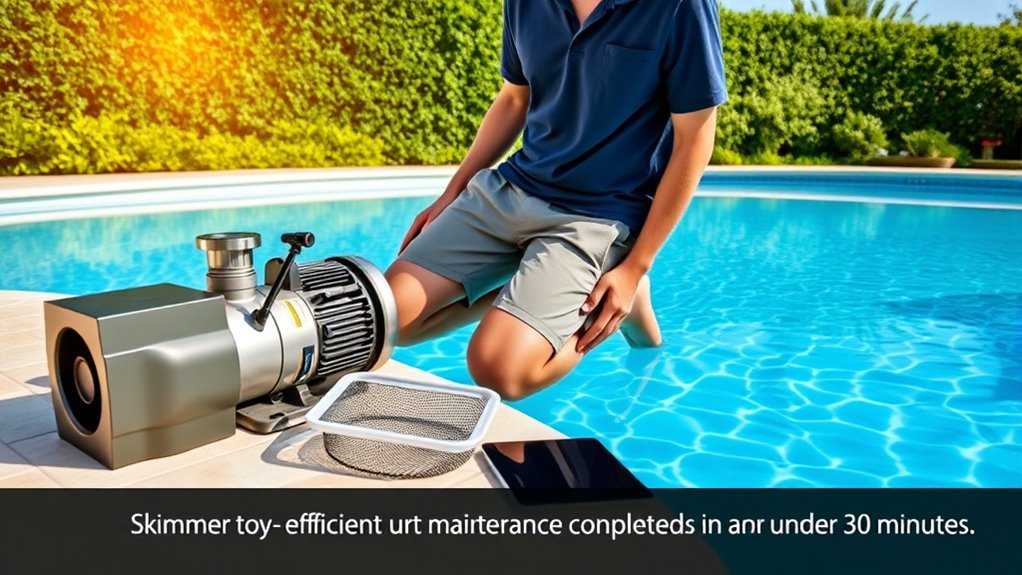
Regularly inspecting your pool equipment helps catch problems early before they become costly repairs. Start by checking the pump and filter for leaks, cracks, or unusual noises. Ensure the pump lid is secure and the strainer basket is clean, preventing blockages. Look over the hoses and connections for wear or leaks. Test the pressure gauge; if it’s abnormally high or low, it could signal a problem. Inspect the skimmer and return jets for blockages or debris, ensuring proper water flow. Examine the pool’s equipment area for signs of rust, corrosion, or loose fittings. Address any issues promptly to keep your system running efficiently. A quick weekly check saves you money and hassle by preventing small problems from escalating.
Wipe Down Pool Accessories and Surroundings
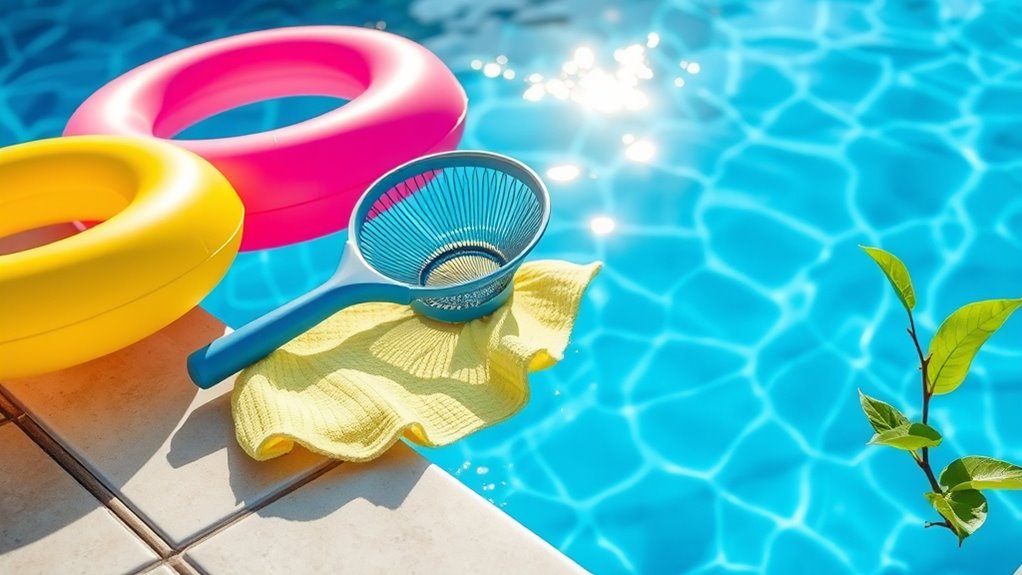
To keep your pool area inviting and safe, wipe down your pool accessories and surrounding surfaces weekly. This helps prevent dirt, algae, and grime buildup that can make your space look unkempt or unsafe. Grab a soft cloth or sponge and wipe down items like pool noodles, floaties, and cleaning tools. Don’t forget to clear off the deck or patio furniture, so they stay clean and inviting. Imagine bright pool floats glistening under the sun, clean poles ready for skimming, and tidy loungers waiting for relaxation. Regularly cleaning these surfaces not only enhances your pool’s appearance but also extends the life of your accessories. A quick wipe-down keeps your pool area safe, fresh, and ready for your next swim.
Frequently Asked Questions
How Often Should I Perform Each Pool Maintenance Task Weekly?
You should skim your pool daily to remove debris and check the water level. Test water chemistry twice a week to keep pH and chlorine balanced. Brush the pool walls weekly to prevent algae buildup. Run your filter 4-6 hours daily or as needed based on usage. Shock the pool once a week, especially after heavy use or rain. Regularly clear out skimmer and pump baskets to ensure proper circulation.
What Signs Indicate My Pool Needs Professional Repairs?
You’ll want to call a professional if you notice persistent cloudy water, algae growth, or a strong chemical smell. Cracks, leaks, or uneven water levels are signs of structural issues. If your skimmer basket or filter clogs frequently despite cleaning, it could indicate a problem. Unusual noises from the pump or heater, or a sudden drop in water clarity, also suggest you should seek expert help to prevent further damage.
Can I Use Household Chemicals for Pool Maintenance Safely?
You can’t treat your pool like a home chemistry set; household chemicals aren’t designed for swimming pools and can cause chaos. Using them risks upsetting the delicate balance of your pool’s water, potentially leading to cloudy water, algae blooms, or damage to your equipment. Stick to pool-specific chemicals—they’re crafted to keep your water crystal clear and safe, turning your pool into a invigorating oasis, not a chemical disaster zone.
How Do Weather Conditions Affect My Weekly Pool Routine?
Weather conditions considerably influence your weekly pool routine. After heavy rain, you’ll need to check and adjust chemical levels, especially chlorine, to prevent algae growth. Hot, sunny weather increases evaporation and algae risk, so you should add algaecide and monitor pH levels more frequently. Wind can blow debris into your pool, requiring you to skim more often. Always test water chemistry after storms or temperature changes to keep your pool balanced and safe.
What Safety Precautions Should I Follow During Pool Cleaning?
Did you know that slipping on wet surfaces causes about 1 million injuries worldwide each year? When cleaning your pool, always wear non-slip shoes and gloves to prevent accidents. Keep electrical devices away from water, and use a sturdy ladder for safe access. Never leave cleaning tools unattended, and make certain your pool area is well-lit. These precautions protect you and make your maintenance routine safer and more effective.
Conclusion
By dedicating just a few minutes each week, you keep your pool’s sparkle shining bright and inviting. With a little attention, your oasis remains a tranquil retreat, free from unwelcome surprises. Think of it as tending a garden—your effort nurtures a beautiful, invigorating haven that’s always ready for your next swim. Keep up this simple routine, and your pool will always be a welcoming escape, reflecting your care and dedication.
